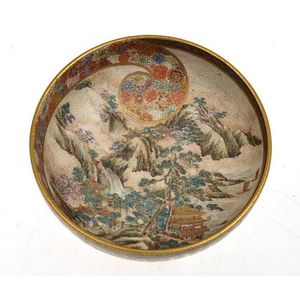Antique Satsuma Charger with Immortal Decoration
You must be a subscriber, and be logged in to view price and dealer details.
Subscribe Now to view actual auction price for this item
When you subscribe, you have the option of setting the currency in which to display prices to $Au, $US, $NZ or Stg.
- Charger - A charger is a type of large plate, typically used as a decorative base for smaller plates or bowls. They are often used in formal settings, such as at a banquet or a special occasion.
The history of chargers can be traced back to medieval times, when they were used as a base for serving dishes in banquet settings. They were typically made of metal, such as silver or pewter, and were highly decorative, often featuring intricate engravings or designs.
During the Renaissance period, chargers began to be made of porcelain, and their designs became more ornate. They were often used in the homes of the wealthy and were considered a symbol of wealth and status.
In the 18th and 19th centuries, chargers were produced in great numbers by European porcelain manufacturers, and they were exported to America and other parts of the world. They were highly sought after by the upper class and were often used as a decorative element in formal table settings. - Circa - A Latin term meaning 'about', often used in the antique trade to give an approximate date for the piece, usually considered to be five years on either side of the circa year. Thus, circa 1900 means the piece was made about 1900, probably between 1895 and 1905. The expression is sometimes abbreviated to c.1900.
- Earthenware - A basic ceramic material that is fired at a low temperature. Earthenware is the basis of almost all ancient, medieval, Middle Eastern and European painted ceramics. After firing, the colour is the colour of the clay when it is dug from the ground: buff, brown and red. It is not waterproof until glazed. Creamware is a type of earthenware covered with a transparent lead glaze. Majolica, faience and delft are also earthenware covered in an opaque white tin glaze.
This item has been included into following indexes:
Visually similar items

Japanese Satsuma bowl with decorative internal mountain scene and external floral garland, yasuda trademark, 4 cm high, 10.5 dia

Impressive Japanese Satsuma bowl with internal geisha scene with raised gilding, slight rubbing around lip, signed Kinkozan, 5 cm high, 13 cm dia

A Japanese Satsuma bowl Meiji period / signed Kyoto Tojiki Goshigaisha Internally decorated with a mountainous scene black and gilt signature to base 11 cm diameter

Australian gold sovereign 1901 Melbourne
